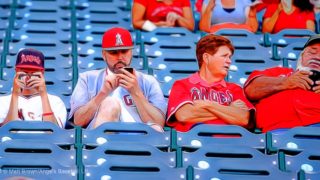Baseball is an exciting game with rules and regulations that all exist for a reason: they protect players and teams from avoidable injuries and unfair advantages, and they make the game more fascinating and entertaining for spectators and bettors. Before getting onto the field, every baseball player, regardless of position, must have a thorough command of advanced baseball basic terms. But these basic terms are only understood by baseball aficionados; one such term is a crooked number.
What Is a Crooked Number in Baseball?
In baseball, the numeral “1” is regarded as “crooked” when calculating the total of runs scored by each team. The “1” is often drawn with a diagonal line, making it seem slanted. While a “straight” line has a score of zero, a “crooked” or oblique line scores one or more.
Crooked numbers in baseball are significant because they indicate a change in the game’s momentum and discourage the opposing team. Baseball keeps score using a hybrid system of symbols and numerals. Each game’s outcomes are recorded in individual cells on a grid-based scorecard. The rows represent the various teams, while the columns represent the multiple innings.
When a team scores, the scorekeeper deletes the “0” from the losing team’s box and writes the winning team’s run total. When a team scores multiple runs in an inning, the “1” in their score box will be tilted leftward, representing a crooked number. This occurs exclusively when the team scores more than one run in that particular inning.
The number is sometimes referred to in contemporary baseball as a “one with a line through it.” This is because the phrase “crooked number” is seldom seen in baseball. It is, nevertheless, considered part of baseball’s legacy and tradition and is often employed in nostalgic allusions to the sport’s rules and past.
Why Do They Call It a Crooked Number?
In baseball, a “crooked number” refers to a score greater than one in an inning, while a “straight” number signifies a single run scored by a team in an inning. This terminology captures the distinction between multi-run and single-run innings. However, a team’s score is deemed “crooked” if it scores two, three, or more runs.
The term’s origin has yet to be discovered. However, it might be related to the widespread description of non-multiples-of-ten numbers as “crooked” in other contexts. In baseball, it is often a sign of a winning game. Sports betting enthusiasts can also use it to determine the best team to bet on and win rewards, including the new casino no deposit bonuses. Unlike bets on football and basketball games, which sometimes feature a point spread, most baseball bets do not. Casino bets on baseball are often put on the money line, which entails predicting the winner of the game.
How to Score Crooked Number
To score, teams must be patient at the bat, make strong contact, and capitalize on scoring chances. Small ball strategies like teams may use bunting and stealing bases to move runners into scoring positions and boost their team’s scoring chances.
Winning baseball games depends on various things, ensuring the scoreboard is not manipulated. Pitchers must remain concentrated and throw strikes, while fielders must stay focused and collaborate efficiently to accomplish even the most basic of plays. So, here’s a small list summarizing the ways to score a crooked number in baseball:
- Hit a home run.
- Score multiple runs on a single play.
- Score in consecutive innings.
- Take advantage of defensive errors.
- Execute a successful squeeze play.
- Steal home base.
What Does a Crooked Number Mean in Curling?
The term “crooked number” originates from curling, describing an end where a team scores more than one point. Because a “straight” end in curling always results in one point for one group, the word “crooked” refers to an end that does not follow this pattern. As a result, a “crooked” end is one in which the points are not appropriately distributed.
Because the side with the most points after a curling game wins, a substantial advantage gained by scoring several points in a single end may be highly valuable. In curling analysis and commentary, the term signifies a pivotal moment when a team accumulates multiple points within a single end, impacting the overall game dynamics.
Is 11 a Crooked Number?
11 is not a crooked number, contrary to common assumption. The idea of “crooked numbers” is not widely understood or used in mathematics or numerology. Some numerals have specific symbolic meanings in some cultures and beliefs. These interpretations might be about good or bad fortune, spiritual importance, or luck. In certain circumstances, the numeral 11 may have cultural or personal significance. However, in baseball, 11 is not regarded as a crooked number.
“Crooked number” is a term that names the capacity of a team to score two or more runs in a single inning. Because of this quick adjustment in approach, the team may acquire an edge over their opponents. The term itself also refers to how the scoreboard appears when several runs are scored in an inning, creating the impression that it is crooked.
In a tight game, the offensive plan that results in the most questionable statistic might mean the difference between victory and loss. Everyone engaged in baseball, including players, coaches, and spectators, should know the language. It works just as well in casual talk as in serious game analysis. Learning about crooked numbers may lead to greater respect for baseball and a deeper grasp of its complexities.
Teammates on the football field help each other, trust each other, and cooperate with each other in order to win trophies and medals for the game. This brings honor to their team and value to their careers.GS-JJ is a professional soccer medals manufacturer. They have their own free design system and professional designers. They can customize unique medals for your races. Simple, affordable, good quality, welcome to order!





